Quadric
In mathematics, a quadric or quadric surface (quadric hypersurface in higher dimensions), is a generalization of conic sections (ellipses, parabolas, and hyperbolas). It is a hypersurface (of dimension D) in a (D + 1)-dimensional space, and it is defined as the zero set of an irreducible polynomial of degree two in D + 1 variables (D = 1 in the case of conic sections). When the defining polynomial is not absolutely irreducible, the zero set is generally not considered a quadric, although it is often called a degenerate quadric or a reducible quadric.
In coordinates x1, x2, ..., xD+1, the general quadric is thus defined by the algebraic equation[1]
which may be compactly written in vector and matrix notation as:
where x = (x1, x2, ..., xD+1) is a row vector, xT is the transpose of x (a column vector), Q is a (D + 1) × (D + 1) matrix and P is a (D + 1)-dimensional row vector and R a scalar constant. The values Q, P and R are often taken to be over real numbers or complex numbers, but a quadric may be defined over any field.
A quadric is an affine algebraic variety, or, if it is reducible, an affine algebraic set. Quadrics may also be defined in projective spaces; see § Projective geometry, below.
Euclidean plane
Quadrics in the Euclidean plane are those of dimension D = 1, which is to say that they are plane curves. In this case, one talks of conic sections, or conics.
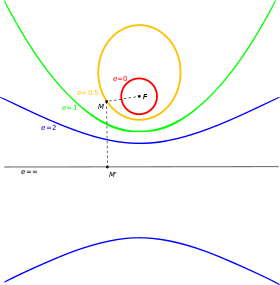
Euclidean space
In three-dimensional Euclidean space, quadrics have dimension D = 2, and are known as quadric surfaces. They are classified and named by their orbits under affine transformations. More precisely, if an affine transformation maps a quadric onto another one, they belong to the same class, and share the same name and many properties.
The principal axis theorem shows that for any (possibly reducible) quadric, a suitable Euclidean transformation or a change of Cartesian coordinates allows putting the quadratic equation of the quadric into one of the following normal forms:
where the are either 1, –1 or 0, except which takes only the value 0 or 1.
Each of these 17 normal forms[2][3] corresponds to a single orbit under affine transformations. In three cases there are no real points: (imaginary ellipsoid), (imaginary elliptic cylinder), and (pair of complex conjugate parallel planes, a reducible quadric). In one case, the imaginary cone, there is a single point ( ). If one has a line (in fact two complex conjugate intersecting planes). For one has two intersecting planes (reducible quadric). For one has a double plane. For one has two parallel planes (reducible quadric).
Thus, among the 17 normal forms, there are nine true quadrics: a cone, three cylinders (often called degenerate quadrics) and five non-degenerate quadrics (ellipsoid, paraboloids and hyperboloids), which are detailed in the following tables. The eight remaining quadrics are the imaginary ellipsoid (no real point), the imaginary cylinder (no real point), the imaginary cone (a single real point), and the reducible quadrics, which are decomposed in two planes; there are five such decomposed quadrics, depending whether the planes are distinct or not, parallel or not, real or complex conjugate.
| Non-degenerate real quadric surfaces | ||
|---|---|---|
| Ellipsoid | 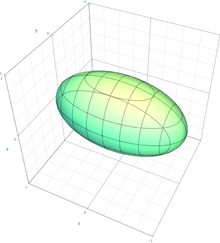 | |
| Elliptic paraboloid | ||
| Hyperbolic paraboloid | 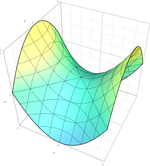 | |
| Elliptic hyperboloid of one sheet |  | |
| Elliptic hyperboloid of two sheets | 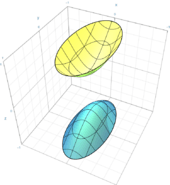 | |
| Degenerate real quadric surfaces | ||
|---|---|---|
| Elliptic cone | ||
| Elliptic cylinder | 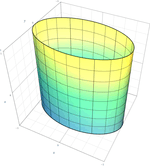 | |
| Hyperbolic cylinder | 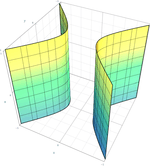 | |
| Parabolic cylinder | 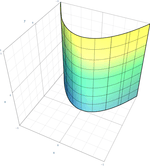 | |
When two or more of the parameters of the canonical equation are equal, one gets a quadric of revolution, which remains invariant when rotated around an axis (or infinitely many axes, in the case of the sphere).
| Quadrics of revolution | ||
|---|---|---|
| Oblate and prolate spheroids (special cases of ellipsoid) |   | |
| Sphere (special case of spheroid) | 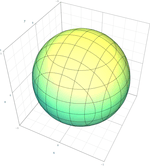 | |
| Circular paraboloid (special case of elliptic paraboloid) |  | |
| Circular hyperboloid of one sheet (special case of elliptic hyperboloid of one sheet) |  | |
| Circular hyperboloid of two sheets (special case of elliptic hyperboloid of two sheets) | 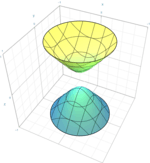 | |
| Circular cone (special case of cone) | 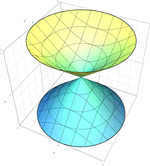 | |
| Circular cylinder (special case of elliptic cylinder) |  | |
Definition and basic properties
A quadric is the set of zeros of a polynomial of degree two. When not specified otherwise, the polynomial is supposed to have real coefficients, and the zeros are points in a Euclidean space. However, most properties remain true when the coefficients belong to any field and the points belong in an affine space. As usually in algebraic geometry, it is often useful to consider points over an algebraically closed field containing the polynomial coefficients, generally the complex numbers, when the coefficients are real.
This define affine quadrics. Many properties becomes easier to state (and to prove) by extending the quadric to the projective space by projective completion consisting of adding points at infinity. Technically, if
is a polynomial of degree two that defines an affine quadric, then its projective completion is defined by homogenizing p into
(this is a polynomial, because the degree of p is two). The points of the projective completion are the points of the projective space whose projective coordinates are zeros of P.
Equation
A quadric in an affine space of dimension n is the set of zeros of a polynomial of degree 2, that is the set of the points whose coordinates satisfy an equation
where the polynomial p has the form
where if the characteristic of the field of the coefficients is not two and otherwise.
If A is the (n + 1)×(n + 1) matrix that has the as entries, and
then the equation may be shortened in the matrix equation
The equation of the projective completion of this quadric is
or
with
These equations define a quartic as an algebraic hypersurface of dimension n – 1 and degree two in a space of dimension n.
Normal form of projective quadrics
The quadrics can be treated in a uniform manner by introducing homogeneous coordinates on a Euclidean space, thus effectively regarding it as a projective space. Thus if the original (affine) coordinates on RD+1 are
one introduces new coordinates on RD+2
related to the original coordinates by . In the new variables, every quadric is defined by an equation of the form
where the coefficients aij are symmetric in i and j. Regarding Q(X) = 0 as an equation in projective space exhibits the quadric as a projective algebraic variety. The quadric is said to be non-degenerate if the quadratic form is non-singular; equivalently, if the matrix (aij) is invertible.
In real projective space, by Sylvester's law of inertia, a non-singular quadratic form Q(X) may be put into the normal form
by means of a suitable projective transformation (normal forms for singular quadrics can have zeros as well as ±1 as coefficients). For surfaces in space (dimension D = 2) there are exactly three nondegenerate cases:
The first case is the empty set.
The second case generates the ellipsoid, the elliptic paraboloid or the hyperboloid of two sheets, depending on whether the chosen plane at infinity cuts the quadric in the empty set, in a point, or in a nondegenerate conic respectively. These all have positive Gaussian curvature.
The third case generates the hyperbolic paraboloid or the hyperboloid of one sheet, depending on whether the plane at infinity cuts it in two lines, or in a nondegenerate conic respectively. These are doubly ruled surfaces of negative Gaussian curvature.
The degenerate form
generates the elliptic cylinder, the parabolic cylinder, the hyperbolic cylinder, or the cone, depending on whether the plane at infinity cuts it in a point, a line, two lines, or a nondegenerate conic respectively. These are singly ruled surfaces of zero Gaussian curvature.
We see that projective transformations don't mix Gaussian curvatures of different sign. This is true for general surfaces. [4]
In complex projective space all of the nondegenerate quadrics become indistinguishable from each other.
Quadratic forms
Let
be a field and
a vector space over
. A mapping
from
to
such that
- (Q1) for any and .
- (Q2) is a bilinear form.
is called quadratic form. The bilinear form is symmetric.
In case of
we have
, i.e.
and
are mutually determined in a unique way.
In case of
we have always
, i.e.
is
symplectic.
For and ( is a base of ) has the form
- and
- .
For example:
Advanced properties
Below let be a field, , and the n-dimensional projective space over , i.e.
the set of points. ( is a (n + 1)-dimensional vector space over the field and is the 1-dimensional subspace generated by ),
the set of lines.
Additionally let be a quadratic form on vector space . A point is called singular if . The set
of singular points of is called quadric (with respect to the quadratic form ). For point the set
is called polar space of (with respect to ). Obviously is either a hyperplane or .
For the considerations below we assume: .
Example: For we get a conic in .
For the intersection of a line with a quadric we get:
Lemma: For a line (of ) the following cases occur:
- a) and is called exterior line or
- b) and is called tangent line or
- b′) and is called tangent line or
- c) and is called secant line.
Lemma: A line through point is a tangent line if and only if .
Lemma:
- a) is a flat (projective subspace). is called f-radical of quadric .
- b) is a flat. is called singular radical or -radical of .
- c) In case of we have .
A quadric is called non-degenerate if .
Remark: An oval conic is a non-degenerate quadric. In case of its knot is the f-radical, i.e. .
A quadric is a rather homogeneous object:
Lemma: For any point there exists an involutorial central collineation with center and .
Proof: Due to the polar space is a hyperplane.
The linear mapping
induces an involutorial central collineation with axis
and centre
which leaves
invariant.
In case of
mapping
gets the familiar shape
with
and
for any
.
Remark:
- a) The image of an exterior, tangent and secant line, respectively, by the involution of the Lemma above is an exterior, tangent and secant line, respectively.
- b) is pointwise fixed by .
Let be the group of projective collineations of which leaves invariant. We get
Lemma: operates transitively on .
A subspace of is called -subspace if (for example: points on a sphere or lines on a hyperboloid (s. below)).
Lemma: Any two maximal -subspaces have the same dimension .
Let be the dimension of the maximal -subspaces of . The integer is called index of .
Theorem: (BUEKENHOUT) For the index of a non-degenerate quadric in the following is true: .
Let be
a non-degenerate quadric in
, and
its index.
- In case of quadric is called sphere (or oval conic if ).
- In case of quadric is called hyperboloid (of one sheet).
Example:
- a) Quadric in with form is non-degenerate with index 1.
- b) If polynomial is irreducible over the quadratic form gives rise to a non-degenerate quadric in .
- c) In the quadratic form gives rise to a hyperboloid.
Remark: It is not reasonable to define formally quadrics for "vector spaces" (strictly speaking, modules) over genuine skew fields (division rings). Because one would get secants bearing more than 2 points of the quadric which is totally different from usual quadrics. The reason is the following statement.
Theorem: A division ring is commutative if and only if any equation has at most two solutions.
There are generalizations of quadrics: quadratic sets. A quadratic set is a set of points of a projective space with the same geometric properties as a quadric: every line intersects a quadratic set in at most two points or is contained in the set.
See also
References
- ↑ Silvio Levy Quadrics in "Geometry Formulas and Facts", excerpted from 30th Edition of CRC Standard Mathematical Tables and Formulas, CRC Press, from The Geometry Center at University of Minnesota
- ↑ Stewart Venit and Wayne Bishop, Elementary Linear Algebra (fourth edition), International Thompson Publishing, 1996.
- ↑ Sameen Ahmed Khan,Quadratic Surfaces in Science and Engineering, Bulletin of the IAPT, 2(11), 327–330 (November 2010). (Publication of the Indian Association of Physics Teachers).
Sameen Ahmed Khan, Coordinate Geometric Generalization of the Spherometer and Cylindrometer, arXiv:1311.3602
(Apparently, these unreliable sources forget one case) - ↑ S. Lazebnik and J. Ponce, "The Local Projective Shape of Smooth Surfaces and Their Outlines" (PDF). , Proposition 1
Bibliography
- M. Audin: Geometry, Springer, Berlin, 2002, ISBN 978-3-540-43498-6, p. 200.
- M. Berger: Problem Books in Mathematics, ISSN 0941-3502, Springer New York, pp 79-84.
- P. Dembowski: Finite Geometries, Springer, 1968, ISBN 978-3-540-61786-0, p. 43.
- Iskovskikh, V.A. (2001) [1994], "Quadric", in Hazewinkel, Michiel, Encyclopedia of Mathematics, Springer Science+Business Media B.V. / Kluwer Academic Publishers, ISBN 978-1-55608-010-4
- Weisstein, Eric W. "Quadric". MathWorld.